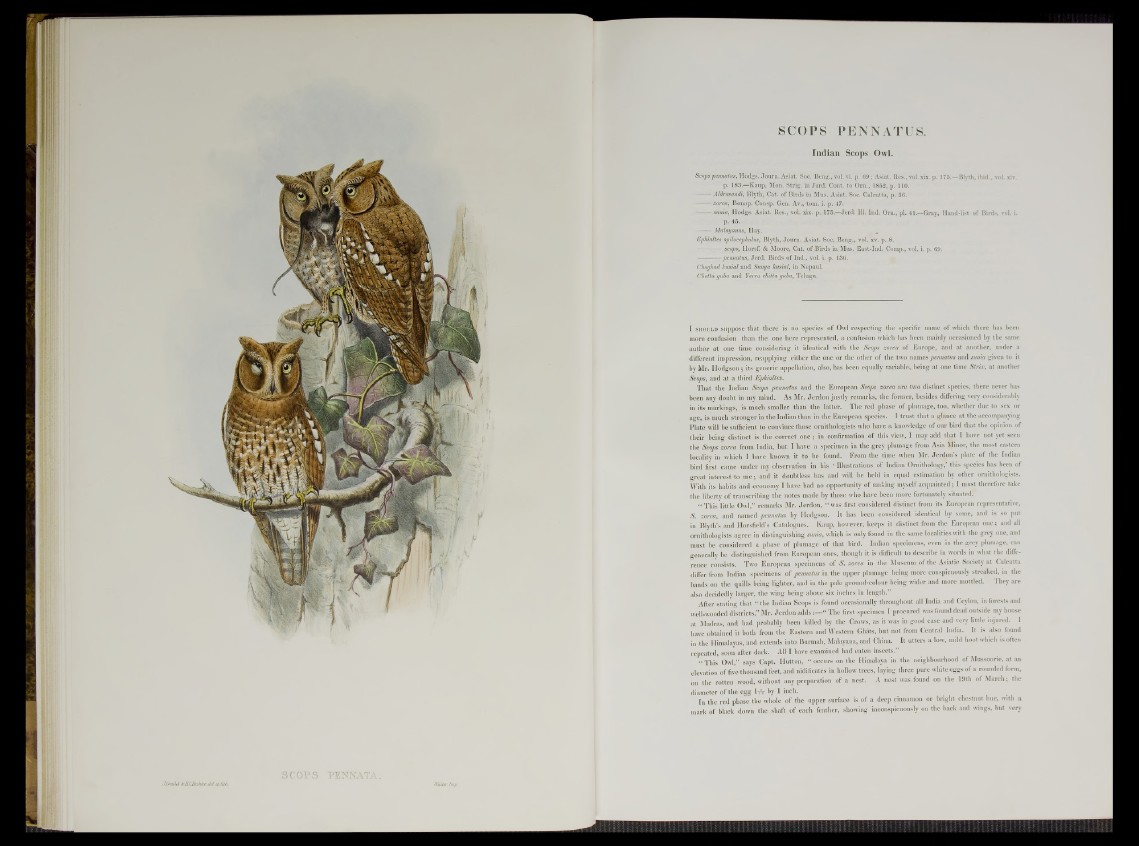
J.GmUL isKCHichta: d el eb Wv.
SCOPS PENNATA.
Walter,Imp.
SCOPS PENNATUS.
Indian Scops Owl.
Scopspennatus, Hodgs. Journ. Asiat. Soc. Beng., vol.fi. p. 69; Asiat. Res., vol. xix. p. 175.—Blyth, ibid., vol. xiv.
p. 183.—Kaüp, Mon. Strig. in Jardl Cont. to Örn., 1852, p. 110.
Alärövaiidi, Blyth, Cat. of Birds in MuS. Asiat. Soc. Calcutta, p. 36.
— zorca, Bonap. Consp. Gen. Av., tom. i . p. 47.
sunia, Hodgs. Asiat. Res., vol. xix. p. 175.—Jerd. 111. Ind. Om., pl. 41.—Gray, Hand-list of Birds, vol. i.
p. 45.-
— Malayanus, Hay. §|
Ephialtes spilocephalus, Blyth, Journ. Asiat. Soc.. Beng., vol. xv. p. 8.
— scops, Horsf. & Moore, Cat. of Birds in Mus. East-Ind. Comp., vol. i. p. 69.
---------- -pennatus, Jerd. Birds of Ind., vol. i. p. 136.
Choghad kusial and Sunya kusial, in Nepaul.
Ghetto, guba and Yerra chitta guba, Telugu.
I s h o u l d suppose that there is no species of Owl respecting the specific name of which there has been
more confusion than the one here represented, a confusion which has been mainly occasioned by the same
author at one time considering it identical with the Scops zorca of Europe, and at another, under a
different impression, reapplying either the one or the other of the two names pennatus and sunia given to it
by Mr. Hodgson; its generic appellation, also, has been equally variable,, being at one time Striv, at another
Scops, and at a third Ephialtes.
That the Indian Scops pennatus and the European Scops zorca are two distinct species, there never has
been any doubt in my mind. As Mr. Jerdon justly remarks, the former, besides differing very considerably
in its markings, is much smaller than the latter. The red phase of plumage, too, whether due to sex or
age, is much stronger in the Indian than in the European species. I trust that a glance at the accompanying
Plate will be sufficient to convince those ornithologists who have a knowledge of our bird that the opinion of
their being distinct is the correct one; in confirmation of this view, I may add that I have not yet seen
the Scops zorca from India, but I have a specimen in the grey plumage from Asia Minor, the most eastern
locality in which I have known it to be found. From the time when Mr. Jerdon’s plate of the Indian
bird first came under my observation in his ‘ Illustrations of Indian Ornithology,’ this species has been of
great interest to me; and it doubtless has and will be held in equal estimation by other ornithologists.
With its habits and economy I have had no opportunity of making myself acquainted; I must therefore take
the liberty of transcribing the notes made by those who have been more fortunately situated.
“ This little Owl,” remarks Mr. Jerdon, “ was first considered distinct from its European representative,
S. zorca, and named pennatus by Hodgson. It has been considered identical by some, and is so put
in Blyth’s and Horsfield’s Catalogues. Kaup, however, keeps it distinct from the European one; and all
ornithologists agree in distinguishing sunia, which is only found in the same localities with the grey one, and
must be considered a phase of plumage of that bird. Indian specimens, even in the grey plumage, can
generally be distinguished from European ones, though it is difficult to describe in words in what the difference
consists. Two European specimens of S. zorca in the Museum of the Asiatic Society at Calcutta
differ from Indian specimens of pennatus in the upper plumage being more conspicuously streaked, in the
bands on the quills being lighter, and in the pale ground-colour being wider and more mottled. They are
also decidedly larger, the wing being above six inches in length.”
After stating that “ the Indian Scops is found occasionally throughout all India and Ceylon, in forests and
well-wooded districts,” Mr. Jerdon adds:—“ The first specimen I procured was found dead outside my house
at Madras, and had probably beeu killed by the Crows, as it was in good case and very little injured. I
have obtained it both from the Eastern and Western Ghats, but not from Central India. It is also found
in the Himalayas, and extends into Burmah, Malayana, and China. It utters a low, mild hoot which is often
repeated, soon after dark. All I have examined had eaten insects.”
“ This Owl,” says Capt. Hutton, “ occurs on the Himalaya in the neighbourhood of Mussoorie, at an
elevation of five thousand feet, and nidificates in hollow trees, laying three pure white eggs of a rounded form,
on the rotten wood, without any preparation of a nest. A nest was found on the 19th of March; the
diameter of the egg l-jV hy 1 inch.
In the red phase the whole of the upper surface is of a deep cinuamon or bright chestnut hue, with a
mark of black down the shaft of each feather, showing inconspicuously on the back and wings, but very